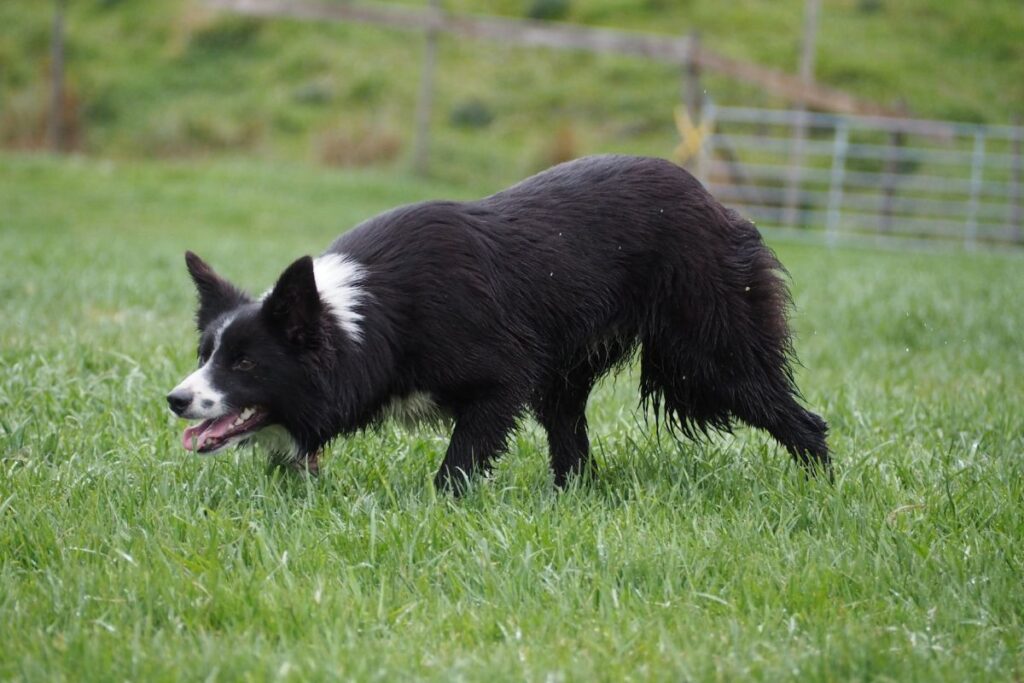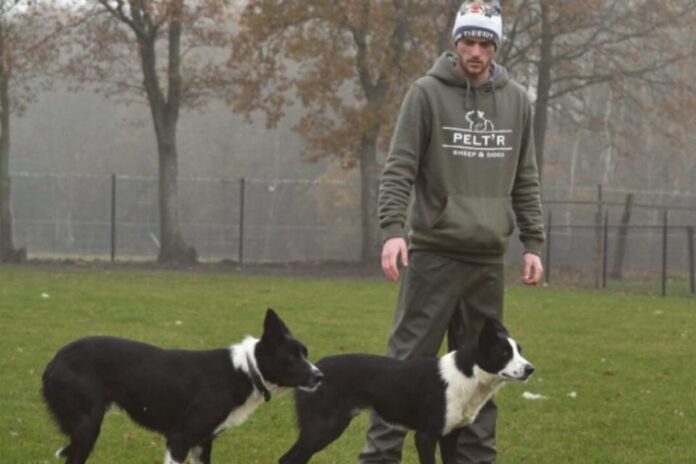That’s Farming editor, Catherina Cunnane, in conversation with Ben De Kerf (26), a sheepdog trainer and breeder.
“I (Ben) am originally from Belgium but living in Norway, and Kristin Marie Guldahl is from Norway, but together, we run Belway Sheepdogs
Both our great grandparents were farmers, but unfortunately, we do not come directly from a farming background but completed agriculture courses in high school.
Kristin used to help out on a farm since she could walk together with her dad. They had some cows and helped around her aunties farm who have sheep.
I grew up with dogs and started getting into farming sheep and training border collies when I was about 15 years of age.
Currently, I am a full-time dog trainer, and Kristin is working part-time as a teacher at a school.
Sheepdogs generate the most income for us. We have some sheep, but they are used for training our dogs. It is an old Norwegian breed named the ‘Villsau’.
This is a harsh breed that thrives tremendously well in the mountains and forests (yes, they keep sheep in forests in Norway).
They do not generate a lot of meat, but because of the low labour costs and the grants provided by the government, they have some real value.
Sheepdogs
We have about 15 dogs at the moment. While writing this interview, we are busy moving to a new bigger place. Here, we can have a capacity for around 25 collies.
We have some litters every year. The main reason for this activity is to keep a new generation ourselves. I do not breed a litter of pups without the intention of having some for our own.
Breeding is always a bit of gambling as well. You can have two superstars, and their offspring could be useless working dogs.
But in my opinion, by looking at the parents, we can reduce our gambling part a lot. I like to breed from dogs who prefer working over anything else on this planet and keep on going no matter what.
Dogs who show a natural ability of ‘reading’ sheep. With reading, I mean mostly: anticipating the movements of sheep, predicting where a sheep wants to go and trying to control that movement by going a certain direction.
I do not like a dog that runs without using his brain and without a plan. Every movement the dog makes needs to make sense for the work that has to be done.
Other than that, a lovely temperament towards people and other dogs. Because our dogs are divided into different groups, they need to get along well.
I had my first border collies when I was 16, and Kristin was 21 when she discovered her passion for this breed.
Both of these dogs are lying down next to my feet while writing this interview. My first litter was about two years after having my first dog.
We only breed dogs if we have the intention of keeping some of the pups ourselves. This is so we can train them and make them the working companions that we love to have.

Training
I always try to have around ten dogs in training and some youngsters coming up whom we occasionally try on sheep to get them going.
So when the older ones are ready to go, we have the next generation ready for training. It also depends on the weather. Winter in Norway can be quite strong. So we try to have fewer dogs in for training and focus more on breeding and pups.
Some dogs are very talented and learn very quickly. Then they can be fully trained in just a couple of months. Others are not so gifted, and it might take two-plus years after their first training session. It also depends on the training frequency, twice a week or twice a day.
I made it into the Norwegian team in 2021 with a young male I have, named Billy. There were more than 350 dogs starting, and he ranked at number 4 by the end of the season at two years of age.
I have sold dogs across Belgium, Norway, Wales, Scotland, Switzerland, France, The Netherlands and Spain.
I was involved in demos while living in Belgium, but it is not such a big thing in Norway.
Involvement, training phase and trails
When I was 16, I did an internship at a local shepherd in Belgium. I was so amazed by the teamwork between humans and dogs that I was determined to start this as well. It all depends on the dog.
There are probably hundreds of different opinions about how to train a dog properly. The first thing that is important is to figure out what you want to use your dog for.
If it is to get five sheep in a stable every couple of months, then the training is not so intense as if you’re running a big hill farm with thousands of sheep. Some people only train for sheepdog trials.
The training will be different here as well. The basic principle of starting a dog is learning the dog to have respect for the sheep.
Learn not to chase them all over the field and stop them from griping. Then learning them to stop and circle around the sheep and learning the flanking commands (clockwise and anti-clockwise).
A good recall is something important as well. These basic steps are the foundation that I use for starting up a young dog.
Tips for readers
Take your time while training. Do not go out on the field training your sheepdog when you only have a quick five minutes.
Try to think before you head out about what to learn about your dog or what you want to work on. Sometimes your plan fails; that is perfectly normal, so do not be disappointed.
I like to take my time to teach them how to work sheep and therefore train them fully before using them in work.
Others learn their dogs by getting them into working situations very early. I think both ways can work fine. If a training does not turn out the way you wanted it to turn out, take a break and try again later on or the next day.
This often has a better result. I could continue endlessly, but maybe the last very important tip I would love to give is about expectations. Know the limits of your dog while training.
Do not expect miracles in a few training sessions. It takes blood (when falling on your face trying to catch a young dog), sweat (from trying to catch that same young dog) and tears (after 40 minutes of chasing and still not being able to catch that little dog).
This probably means that your beloved sheepdog was not completely ready to be out on a big field, and the expectations were too big.
I learned a lot by looking at the great sheepdog people in the world. ‘Stealing with your eyes’ is, in my opinion, the best way to learn.
Look at their timing (in trials), their connection with the dogs they handle and why they do certain things whilst training.
I like the process of working with sheepdogs. I love the process of making an uncontrollable rocket to a fully trustable mate that you can cooperate with for years.
When working with live animals, you never exactly know how things go. If it is with sheep, cows, and chickens, it is exactly the same with dogs. So I would say, patience is a must and learning to accept that things do not always go as planned while training dogs.

Trialling
I started trialling when I was 17. I had some success in the past, but I have much room for improvement.
Previously, I became the Belgium national and reserve champion and nursery champion (dogs under three years).
Moreover, I ran for the Belgian team at the world trial and ran some good trials in Wales in the past and now recently trialling in Norway, which started well for me.
Kristin is very new in trialling. Training dogs, being a teacher, mommy and pregnant at the same time is not an easy combination. So her trial career is taking a break now.
Patience and determination are the two key words for me.
A typical day involves getting up and spending time with the family first. Then, my day involves going up to the dogs, cleaning the kennels and letting the dogs out.
Then the training starts before having lunch and more training afterwards, followed by feeding them and getting them ready for the night.
Of course, as I said before, expect the unexpected. Sometimes sheep run off, dogs can decide to break out, or you could have a vet visit, so every day is different in its own way.
Favourite dog
The one I like the most is the one I am running now: Kemi Billy, bred by Kevin Evans. He has always been special since he was just a tiny pup.
I love his energy and mindset, and he will always go and never give up. He is not the easiest to handle, but somehow we manage fine.
I know him inside out, which often gives me an advantage on trials. Knowing your dog and how he is, responds, reacts or acts in different situations is very important.
Because we are not from a farming background and do not have any farm of ourselves (yet), the biggest challenge is finding the right possibilities to train and work our dogs.
At the moment, we are still depending on other people, and at some point, I would love to change that.

Reflection
I cannot change the past. The route has not always been easy and still is not. It is not always easy to make a living from working with animals.
But I think today, in the farming industry or other agriculture businesses; nothing is easy. If it were not for the love and passion that farmers have for their job, there would not be many around anymore.
The big dream is to have our own farm and produce something that you can be proud of, and in our case, this would be farming sheep.
This, in combination with the passion for training sheepdogs, sounds perfect to me. I feel for us to be able to start up a farm, the training and selling of working border collies can help us achieve this goal.
I started working with sheep and dogs in 2013 in combination with school. Since then, I have been working part-time/studying and training dogs/working with sheep.
In 2019, I quit my job in Belgium and moved to Wales to train dogs, and in 2020, I moved to Norway, and the rest is history.”
To share your story like this sheepdog trainer, email – [email protected]
Other news articles on That’s Farming:





